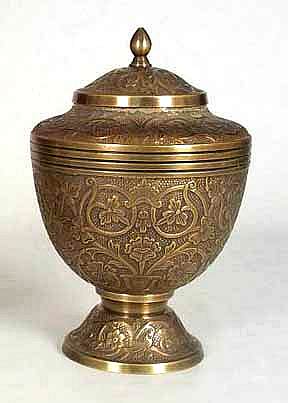 Cremation in North America has been on the rise for decades. In 1985 the percentage of deaths cremated was only 15%. In 1995 the number shot up to about 20%. By 2005 the percentage increased to just over 32%. By 2015 the projected figure is almost 45%, and in 2025, 55%.
Cremation in North America has been on the rise for decades. In 1985 the percentage of deaths cremated was only 15%. In 1995 the number shot up to about 20%. By 2005 the percentage increased to just over 32%. By 2015 the projected figure is almost 45%, and in 2025, 55%.
For centuries, however, Christians have mostly rejected cremation as an acceptable treatment of the remains of loved ones. A biblical reason for this was that the patriarchs and prophets, priests and kings, princes and peasants, were buried in graves or tombs. Cremation was seen as a punishment or curse, not a common treatment of mortal remains (Gen. 38:24; Num. 11:1; Deut. 12:31; Josh. 7:25; 2 Kings 17:17; Ps. 106:18; Isa. 33:12). A theological reason for this was a belief in the bodily resurrection, in which what remained of mortal bodies would be raised anew, glorified, and transformed immortal, never to die again (John 6:28–29; 1 Cor. 15:52; Phil. 3:21; 1 Thess. 4:16). So the burning of remains was often associated with Eastern and Pagan religious traditions that viewed the physical body as an inferior, evil substance to be escaped or overcome rather than a part of God’s original good creation and a partaker in His future redemption.
Yet today many Christians are overcoming the traditional biblical and theological gag reflex associated with cremation by embracing it as a legitimate option. A number of factors contribute to this. First, cremation is significantly cheaper: cremation costs can be between 50% to 80% less than traditional burial, depending on the kinds of services involved! Second, many point out that both decomposition and combustion eventually lead to the same thing: dust and ashes. It’s just that one takes centuries, the other minutes. Third, some insist that cremation is more “green” . . . or at least it takes up less green space. And “green” is all the rage nowadays. Fourth, some Christians regard the body as just so much trash that needs to be discarded. And since some trash is buried and other trash is incinerated, why not do the same with bodies? After all, they reason, “The real me is in heaven with the Lord; I don’t care what happens to my rotten ol’ body.”
I’ll admit, the first reason seems, well, reasonable. Or at least fiscally responsible. The second reason is true: though the chemical processes are a bit different, the end result is more or less similar. The third reason makes sense in a part of the world where land is a premium and the potential for unsanitary burial is high. The final reason, though, is absolute rubbish. The view that the body is insignificant and irrelevant is not a Christian perspective. Period. (See my essay, “Don’t Walk on Those Graves!” for a biblical, theological, and historical explanation of the Christian doctrine of bodily resurrection.)
So, what do we do? On the one had we have traditional biblical and theological reasons to favor burial . . . on the other hand we have, well, let’s be honest—financial and pragmatic reasons (plus one quasi-heretical view of the physical body). It kind of seems pretty clear that the biblical and theological should outweigh the financial and pragmatic, doesn’t it?
Well, not so fast. The truth is, Jews and Christians buried their dead primarily as an act of their belief in the nature of the material body and its future in God’s redemptive plan. They did this explicitly in contrast to religions and cultures that viewed the body as useless trash or believed the body was just borrowed matter that should become one with the physical universe, just as our spirits would be absorbed into the mindless cosmic soul. Christians distinguished themselves in their belief that God will one day raise up the material bodies that had been animated by their immaterial souls, that those bodies originally created good would one day be restored and transformed into glorious bodies that would live forever in a renewed world free of death and corruption. By burying instead of burning, Christians aligned their actions with their beliefs—by their practice they confessed that God would one day win the victory over death through resurrection.
I believe Christians can continue to confess their belief in the resurrection of the body and practice cremation, because it’s not the form in which the mortal remains are preserved that is most important but that the mortal remains are preserved. Christians can distinguish themselves from pagan pantheism and materialistic atheistic by preserving the identity of the remains, whether they are buried or cremated. By maintaining the identity of the departed saint, we confess a belief in the future physical resurrection of his or her remains.
This leads to three practical points for those who choose cremation over burial.
First, avoid any actions that would confess a pantheistic “becoming one with the universe” theology. Scattering ashes in the wind, dumping them in the sea, fertilizing a lawn or garden, or otherwise mixing them with the world is an action that says, “Joe’s body is no longer Joe. It’s just dirt.” Wrong! Joe’s body is half of Joe! One day God will take Joe’s mortal remains, reconstitute and transform them, and reunite Joe’s soul with Joe’s glorified body! So scattering ashes is probably not a good picture of our belief in the bodily resurrection.
Second, maintain the identity of the remains. Yes, name them. Preserve them. Place them in a marked grave, or label them with a name plate—something that indicates that they are of significance and value both to you and to God. By doing so, you’re saying, “This is Jill. Yes, her spirit is with the Lord, but one day God will redeem Jill’s mortal remains, reversing the curse of death, and declaring victory over it forever.” Through our actions we will confess those final lines of the Apostles’ Creed: “I believe . . . in the resurrection of the body and the life everlasting.”
Finally, make your wishes—and especially the theological reasons for your wishes—clear to your loved ones. If you believe in the proper place of your physical body in God’s redemptive plan, make sure your loved ones know that you desire for your remains to continue to confess your faith in the gospel promise long after you’re gone. Don’t let your children or grandchildren dispose of your remains as if they were just emptying an ashtray!
Yes, I believe cremation is an option for Christians. God can and will raise up bones, dust, or even ashes on that Great Gettin’ Up Morning. But in the meantime, your desire to maintain the identity of your remains can communicate to others your belief that the darkness will one day give way to dawn, that the sun will break over the horizon, and you’ll answer Christ’s trumpet call to awake from your sleep.




